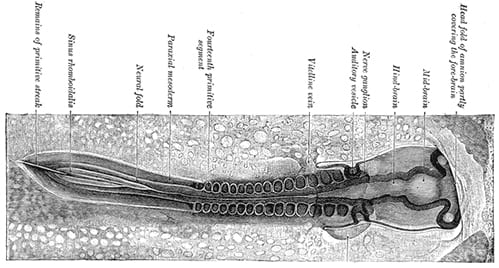As of this writing, DNF’s first egg is five days, one hour old and her second egg is two days, one hour old. The Xcel Energy Fort St. Vrain Eagles have not yet laid eggs.
What do embryonic eagles look they look like as they develop and grow inside their eggs? Dr. Peter Sharpe from the Institute for Wildlife Studies developed a table of bald eagle embryonic development based on work done by Hamburger and Hamilton (1951). While not all bald eagle eggs hatch in 35 days, the stages of development look something like this…
 Development of an avian embryo
Development of an avian embryo
So what happens during the first four days after fertilization? As the fertilized egg begins its journey through a female’s reproductive system, a single cell is formed by the union of sperm and egg. It divides into multiple cells and forms layers. Locations for a head and tail are established, the emerging embryo divides into blocks called somites, and basic life support structures begin to develop, including the nervous system, skin, circulatory system, gastrointestinal system, and optical system. The embryo turns onto its left side. Its heart begins to beat roughly 72 hours after incubation begins.
At four days of age, the embryonic eagle doesn’t look anything like a bird, but it has inside and outside layers, it can transport materials through its developing circulatory system, and its nervous system has an anterior-to-posterior template in place. The brain and nervous system will continue to grow and change, but the stage is set for the development of a skeletal system, limbs, a beak and tongue, foot and wing digits, and organs.
 An embryonic bird in very early stages of development. It has a top, bottom, front, back, left and right sides, and layers.
An embryonic bird in very early stages of development. It has a top, bottom, front, back, left and right sides, and layers.
People sometimes worry when they see blood on the eggs. While blood can look quite alarming, the embryonic eagle is not vascularized enough to produce substantial amounts of blood and may not even have a heart. The contents of the egg are primarily yolk and albumen, so damage will appear not in the form of blood, but as a crack and leak of clear or yellowish fluid. Our eagle parents often have messy lunches and sometimes a little bit gets left behind on their eggs!
Illustrations were taken from Popular Science Monthly/Volume 71/September 1907/The Problem of Age, Growth and Death III: Link. Thanks to artist William Sillin for allowing us to use his lovely illustrations: http://www.willsillin.com/ (check it out – his illustrations are very cool!). Also take a look at this cool plate by Keibel and these lovely photos of chicken embryos: http://www.microscopy-uk.org.uk/mag/artnov04macro/mlchicken.html.
Things that helped me learn about this subject:
 The Raptor Resource Project
The Raptor Resource Project The Raptor Resource Project
The Raptor Resource Project